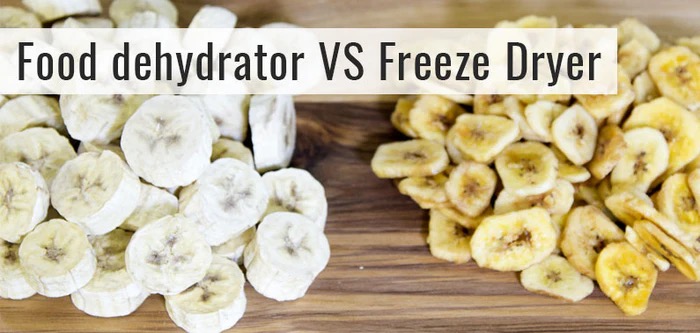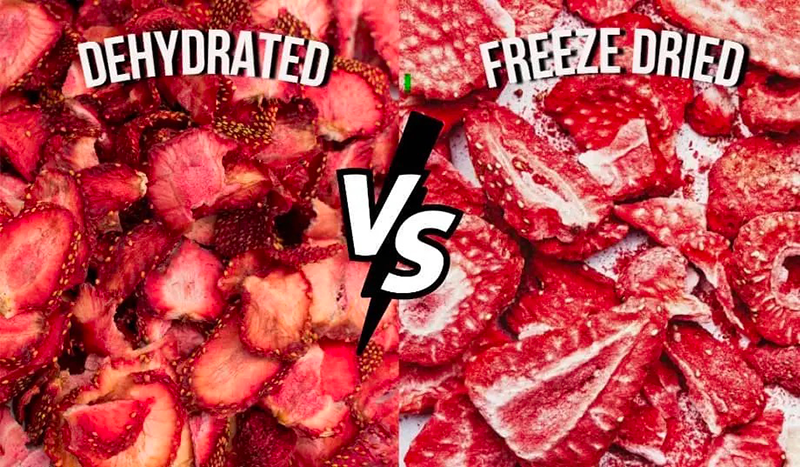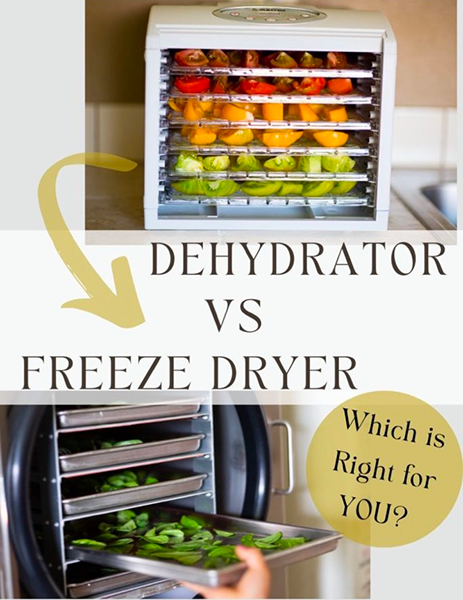
Content Menu
● Understanding Food Dehydrators
>> Key Features of Food Dehydrators
>> Common Types of Food Dehydrators
● Understanding Freeze Dryers
>> Key Features of Freeze Dryers
>> Components of Freeze Dryers
● Comparison Table: Food Dehydrator vs. Freeze Dryer
● Processes Explained
>> How Food Dehydrators Work
>> How Freeze Dryers Work
● Nutritional Value Retention
● Applications and Uses
>> When to Use a Food Dehydrator
>> When to Use a Freeze Dryer
● Cost Considerations
● Maintenance and Cleaning
>> Food Dehydrator Maintenance
>> Freeze Dryer Maintenance
● Conclusion
● FAQ
>> 1. What is the main difference between a food dehydrator and a freeze dryer?
>> 2. Which method retains more nutrients?
>> 3. How long can I store freeze-dried foods?
>> 4. Are freeze dryers worth the investment?
>> 5. Can I use both methods for different types of food?
● Citations:
Food preservation is a crucial aspect of modern culinary practices, especially for those looking to extend the shelf life of their ingredients while maintaining nutritional value. Among the various methods available, food dehydrators and freeze dryers are two popular options. However, many people often wonder: Is a food dehydrator the same as a freeze dryer? This article will explore the differences between these two appliances, their processes, benefits, and applications.

Understanding Food Dehydrators
A food dehydrator is an appliance designed to remove moisture from food through the application of heat and airflow. This method is particularly effective for fruits, vegetables, herbs, and meats. The dehydrator works by circulating warm air around the food, causing moisture to evaporate.
Key Features of Food Dehydrators
- Temperature Range: Typically operates between 90°F to 145°F (32°C to 63°C).
- Moisture Removal: Removes about 85% to 95% of moisture from food.
- Shelf Life: Dehydrated foods can last from several months to a year, depending on storage conditions.
- Cost: Generally more affordable than freeze dryers, with prices starting around $100.
Common Types of Food Dehydrators
Food dehydrators come in various types, including:
- Stackable Tray Dehydrators: These have multiple trays stacked on top of each other and are suitable for small batches.
- Shelf Dehydrators: These have a more robust design with shelves that can hold larger quantities of food.
- Hybrid Dehydrators: These combine convection heating with other methods like microwave or infrared heating for faster drying times.
Each type has its advantages and is suited for different needs based on the volume of food being dried and space considerations.
Understanding Freeze Dryers
In contrast, a freeze dryer employs a more complex process known as sublimation to remove moisture. This involves freezing the food at very low temperatures and then creating a vacuum that allows the ice to convert directly into vapor without passing through a liquid phase.
Key Features of Freeze Dryers
- Temperature Range: Can reach temperatures as low as -40°F (-40°C).
- Moisture Removal: Capable of removing up to 99% of moisture.
- Shelf Life: Freeze-dried foods can last anywhere from 15 to 25 years when stored properly.
- Cost: More expensive than dehydrators, with prices starting at around $2,400.

Components of Freeze Dryers
Freeze dryers consist of several key components:
- Freezing Chamber: Where the food is placed and frozen rapidly.
- Vacuum Chamber: Creates low pressure to facilitate sublimation.
- Heating Element: Provides gentle heat during the sublimation process.
- Control System: Monitors temperature and pressure to ensure optimal conditions for freeze-drying.
Comparison Table: Food Dehydrator vs. Freeze Dryer
| Feature | Food Dehydrator | Freeze Dryer |
| Operating Temperature | 90°F - 145°F | -40°F or lower |
| Moisture Removal | 85% - 95% | Up to 99% |
| Shelf Life | Several months to 1 year | 15 to 25 years |
| Nutritional Retention | Moderate (some loss of heat-sensitive vitamins) | High (retains most nutrients) |
| Cost | Affordable (starting at $100) | Expensive (starting at $2,400) |
| Complexity | Simple operation | Complex operation |
Processes Explained
How Food Dehydrators Work
1. Preparation: Food is sliced and arranged on trays. The uniformity in size ensures even drying.
2. Heating: The dehydrator heats air and circulates it around the food using fans.
3. Moisture Evaporation: Heat causes moisture in the food to evaporate gradually over several hours.
4. Completion: The process can take anywhere from 4 to 12 hours depending on the type and thickness of the food.
5. Storage: Once dried, foods should be stored in airtight containers away from light and moisture to maximize shelf life.
Dehydrating Process
How Freeze Dryers Work
1. Freezing: Food is placed in trays and frozen quickly to very low temperatures using liquid nitrogen or mechanical refrigeration.
2. Vacuum Creation: A vacuum pump removes air from the chamber, creating low pressure necessary for sublimation.
3. Sublimation: Gentle heat is applied while maintaining low pressure; this causes ice within the food to turn directly into vapor without melting.
4. Completion: The process takes anywhere from 20 to 36 hours, depending on the type and amount of food being processed.
5. Storage: Like dehydrated foods, freeze-dried items should be stored in airtight containers for long-term preservation.
Freeze Drying Process
Nutritional Value Retention
One of the significant advantages of freeze drying over dehydration is its ability to retain nutritional value:
- Freeze-dried foods retain about *97%* of their nutrients, including vitamins and minerals.
- In contrast, dehydrated foods may lose some heat-sensitive vitamins like Vitamin C during the drying process due to higher temperatures involved in dehydration.
This difference makes freeze-dried products particularly appealing for health-conscious consumers who want to maintain the nutritional integrity of their foods over extended periods.
Applications and Uses
Both methods have distinct applications based on user needs:
When to Use a Food Dehydrator
- Making snacks like jerky or fruit leathers.
- Preserving seasonal fruits and vegetables for short-term use.
- Creating dried herbs for cooking.
- Preparing ingredients for trail mixes or granola bars.
- Reducing bulk items like bread or crackers into smaller portions for storage.
Food dehydrators are ideal for home users who enjoy making healthy snacks or preserving garden produce without requiring long-term storage solutions.
When to Use a Freeze Dryer
- Long-term storage of emergency food supplies.
- Preserving high-value items like meats or complex meals.
- Maintaining flavor and nutritional integrity for long periods.
- Creating ready-to-eat meals for camping or hiking trips.
- Storing delicate items such as dairy products or desserts that would not fare well in traditional dehydration methods.
Freeze dryers are often used by serious enthusiasts, survivalists, or businesses that require high-quality preserved foods with extended shelf lives.
Cost Considerations
When deciding between a food dehydrator and a freeze dryer, cost is an essential factor:
- Food dehydrators are generally budget-friendly options suitable for casual users or small households. They provide excellent value for those looking to dehydrate fruits, vegetables, or make jerky without significant investment.
- Freeze dryers represent a substantial investment but offer unparalleled preservation capabilities. They are ideal for users who prioritize long-term storage and nutrient retention in their preserved foods.
Maintenance and Cleaning
Proper maintenance is crucial for both appliances:
Food Dehydrator Maintenance
1. Clean trays after every use with warm soapy water.
2. Regularly check heating elements and fans for dust accumulation.
3. Ensure seals are intact to maintain airflow efficiency.
Freeze Dryer Maintenance
1. Clean interior surfaces after each cycle using non-abrasive cleaners.
2. Regularly inspect vacuum pumps and replace filters as needed.
3. Monitor temperature sensors and controls for accuracy.
Maintaining both appliances ensures longevity and optimal performance over time.
Conclusion
In summary, while both food dehydrators and freeze dryers serve the purpose of preserving food by removing moisture, they operate through different processes that yield varying results in terms of nutritional retention, shelf life, cost, complexity, and applications. A dehydrator is suitable for casual users looking for an affordable way to make snacks or preserve seasonal produce. In contrast, a freeze dryer is ideal for serious food preservationists aiming for long-term storage without compromising on quality or nutrition.
The choice between these two appliances ultimately depends on your specific needs—whether you prioritize cost-effectiveness or nutrient preservation over extended periods—and how you plan to use your preserved foods in your culinary endeavors.

FAQ
1. What is the main difference between a food dehydrator and a freeze dryer?
The main difference lies in their processes; dehydrators use heat to evaporate moisture while freeze dryers use freezing and vacuum pressure to sublimate ice directly into vapor.
2. Which method retains more nutrients?
Freeze drying retains more nutrients compared to dehydration due to its low-temperature process that minimizes nutrient loss.
3. How long can I store freeze-dried foods?
Freeze-dried foods can last between 15 to 25 years when stored properly in airtight containers away from light and moisture.
4. Are freeze dryers worth the investment?
If you require long-term food preservation with minimal nutrient loss, investing in a freeze dryer can be worthwhile despite its higher cost.
5. Can I use both methods for different types of food?
Yes! You can use both methods depending on your specific needs; for example, use a dehydrator for snacks and a freeze dryer for long-term storage of meals or high-value items.
Citations:
[1] https://landmarktools.com/blogs/guides/freeze-dryer-vs-dehydrator
[2] https://sedpharma.com/news-events/freeze-dryer-vs-dehydrator/
[3] https://create.vista.com/photos/dehydrator/
[4] https://www.youtube.com/watch?v=mtDzdYoyeR8
[5] https://www.youtube.com/watch?v=TxGEMG-DCnY
[6] https://www.lowes.com/n/buying-guide/freeze-dryer-vs-dehydrator
[7] https://www.freepik.com/free-photos-vectors/food-dehydrator
[8] https://www.youtube.com/watch?v=rR2G5UO-5Ms
[9] https://www.trimleaf.com/blogs/articles/dehydrator-vs-freeze-dryer
[10] https://www.commercialdehydrators.co.uk/post/freeze-drying-vs-dehydration
[11] https://harvestright.com/freeze-drying-vs-dehydrating/











